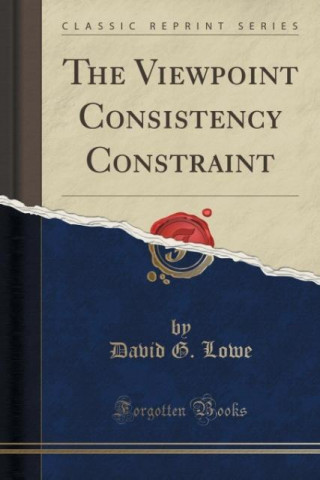
Kod: 14231052
The Viewpoint Consistency Constraint (Classic Reprint)
Autor David G. Lowe
Excerpt from The Viewpoint Consistency Constraint The viewpoint consistency constraint: The locations of all projected model features in an image must be consistent with projection from a single viewpoint. The ease of statin ... więcej
- Język:
 Angielski
Angielski - Oprawa: Miękka
- Liczba stron: 30
Wydawca: Forgotten Books, 2016
- Więcej informacji o książce

Zobacz książki o podobnej tematyce
-

Dune
34.73 zł -33 % -

Haunting Adeline
125.38 zł -1 % -

Berserk Deluxe Volume 2
211.92 zł -1 % -

White Nights
15.25 zł -23 % -

Powerless
48.58 zł -11 % -

Atomic Habits
57.31 zł -28 % -

Dune Messiah
46.17 zł -3 % -

Berserk Deluxe Volume 3
217.44 zł -3 % -

One Day
32.52 zł -36 % -

Berserk Deluxe Volume 1
211.12 zł -2 % -

Iron Flame
60.93 zł -28 % -

Surrounded by Idiots
36.63 zł -28 % -

Harry Potter and the Prisoner of Azkaban (Minalima Edition)
169.86 zł -2 % -

Gravity Falls Journal 3
89.14 zł -

Heaven Official's Blessing: Tian Guan Ci Fu (Novel) Vol. 1
85.32 zł -5 % -

The Creative Act
99.88 zł -15 % -

Dune
47.18 zł -23 % -

Hunting Adeline
126.08 zł -4 % -

A Little Life
46.87 zł -14 % -

Children of Dune
46.57 zł -2 % -

Heaven Official's Blessing: Tian Guan Ci Fu (Novel) Vol. 2
77.49 zł -14 %
Powiadomienie o dostępności
Wpisz swój adres e-mail, aby otrzymać od nas powiadomienie,
gdy książka będzie dostępna. Proste, prawda?
Więcej informacji o The Viewpoint Consistency Constraint (Classic Reprint)
 Opis
Opis
Excerpt from The Viewpoint Consistency Constraint The viewpoint consistency constraint: The locations of all projected model features in an image must be consistent with projection from a single viewpoint. The ease of stating this constraint is deceptive. The mathematical and practical problems of implementing it have been such that few model-based vision systems have made full use of the constraint. Some systems have ignored it altogether while others have used loose approximations that discard much of the inherent information content. However, the importance of this constraint for achieving robust recognition can hardly be overstated, and we will argue that it plays a central role in most instances of human visual recogntion. Since the appearance of a three-dimensional object can change completely as it is projected from different viewpoints, any attempt to recognize an object without application of the viewpoint consistency constraint will end up ignoring most of the constraining aspects of an object's spatial structure. Low-level vision has proved unsuccessful at generating stable, unambiguous features that in themselves provide reliable discrimination between object classes. However, low-level vision provides not only the identity of features, such as edges, but also accurate information regarding their location in the image. It is this large quantity of accurate spatial information that can be exploited through application of the viewpoint consistency constraint. A second area of bottom-up image analysis has focussed upon region description, making use of properties such as color and texture. But once again, in themselves these region descriptions are likely to be of little use without a spatial mapping of the object model to the image that specifies which regions are in correspondence to specific surfaces of the object. Thus, spatial correspondence is often prerequisite to other forms of visual matching that are not explicitly spatial themselves. One argument that is sometimes advanced against the use of precise spatial corre spondence is that many objects are non-rigid with internal degrees of freedom and variable dimensions. It is also clear that human vision has a remarkable capability for recognizingdistorted images and drawings. However, advances will be made on these important prob lems only by explicitly representing the possible degrees of freedom and distortions that are present in a situation. Our knowledge of the visual appearance of objects includes a large amount of information on internal degrees of freedom in their shape and visual properties, as well as potential transformations in the image domain itself. To simply discard all of the available spatial information because some of it is not fully constrained would result in the loss of a large portion of our most useful visual knowledge. It is true, for example, that human vision can identify a person from a highly non-veridical cartoon drawing, yet any amateur artist knows that this is an entirely different proposition from stating that recognition could occur after arbitrary spatial transformations of the image. About the Publisher Forgotten Books publishes hundreds of thousands of rare and classic books. Find more at www.forgottenbooks.com This book is a reproduction of an important historical work. Forgotten Books uses state-of-the-art technology to digitally reconstruct the work, preserving the original format whilst repairing imperfections present in the aged copy. In rare cases, an imperfection in the original, such as a blemish or missing page, may be replicated in our edition. We do, however, repair the vast majority of imperfections successfully; any imperfections that remain are intentionally left to preserve the state of such historical works.
 Szczegóły książki
Szczegóły książki
Kategoria Książki po angielsku Mathematics & science Mathematics Probability & statistics
- Pełny tytuł: The Viewpoint Consistency Constraint (Classic Reprint)
- Autor: David G. Lowe
- Język:
 Angielski
Angielski - Oprawa: Miękka
- Liczba stron: 30
- EAN: 9781333492663
- ISBN: 1333492669
- ID: 14231052
- Wydawca: Forgotten Books
- Waga: 56 g
- Wymiary: 229 × 152 × 2 mm
- Data wydania: 07. September 2016
zadowolonych klientów
Od roku 2008 obsłużyliśmy wielu miłośników książek, ale dla nas każdy był tym wyjątkowym.
Copyright! ©2008-24 libristo.pl Wszelkie prawa zastrzeżonePrywatnieCookies



 21 milionów książek
21 milionów książek Dostawa 10.99 zł
Dostawa 10.99 zł (32) 444 93 66 (8-15.30h)
(32) 444 93 66 (8-15.30h)